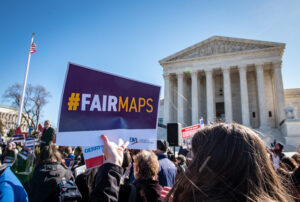Is John Roberts Coming for Your Vote?
Racial nostalgists working to restore white political power through voter suppression may have an ally in the Supreme Court.
Watching the almost uniform sea of white faces in attendance at the 2012 Republican National Convention called to mind one of the defining hallmarks of all reactionary movements of the modern era: Whatever their particular social and historical contexts, they seek not a new future free of past injustices but a return to mythologized past glories.
For today’s tea-party-dominated Republicans, the glorified past is steeped in racial- and gender-based nostalgia. It is a vision of America drawn from simplistic and distorted allusions to the wisdom of the Founding Fathers, the infantile hyper-individualism of Ayn Rand and, on a more mundane level, patriarchal 1950s sitcoms like “Leave It to Beaver.” It is a vision in which clean-cut, white, Christian men hold all positions of responsibility and lead prosperous suburban lives with dutiful and well-coiffed spouses like June Cleaver at their sides. It is a vision in which racial minorities, to the extent that they are ever seen, happily accept their second-class citizenship.
Although the tea party’s invocation of the past has never squared with reality (some of the Founding Fathers were slaveholders; Rand was an atheist; and “Leave It to Beaver” really wasn’t very funny), the principal legal and political tool the tea party and the Republicans have used to restore the past is only too real. That tool is voter suppression, and it not only has deep roots in the nation’s past, but it threatens to play a defining role in both its present and its future.
Contrary to the right’s mythology touting the virtues of our lost democracy, voting was never a truly public pastime during the nation’s formative period. As political scientist Ruy Teixeira, a senior fellow at the Center for American Progress, has noted, only 4 to 6 percent of the eligible electorate (which did not include women, black slaves and in many states white men without property) turned out to vote in the country’s first five presidential elections. And although voter turnout grew markedly after 1824, Jim Crow policies implemented after the Civil War caused turnout rates to nosedive again.
The catalog of suppression techniques included the poll tax, first enacted in Georgia in 1871 and, by 1904, adopted throughout the former Confederacy; the literacy test, first imposed by South Carolina in 1882; white-only primaries; and state laws and local ordinances that made it difficult for black voters to establish residency and register. And where all else failed, the old South was never above outright intimidation of black voters and African-Americans seeking elective office.
The net effect on the franchise was devastating. The Georgia poll tax alone, estimates California Institute of Technology historian J. Morgan Kousser, resulted in a 50 percent drop in black voter turnout. The turnout of poor whites also plummeted, decreasing, according to Kousser, between 16 and 28 percent.
The Supreme Court was a willing participant in the suppression regime, unanimously rejecting a constitutional challenge brought by a 28-year-old impoverished white man to the Georgia poll tax in 1937 (Breedlove v. Suttles). It was not until 1966, after ratification of the 24th Amendment (prohibiting poll taxes in federal elections) and the passage of the Voting Rights Act of 1965, that the high court declared all poll taxes illegal under the equal protection clause of the 14th Amendment (Harper v. Virginia State Board of Elections).
The poll tax’s demise, together with the Voting Rights Act and the Civil Rights movement generally, ushered in a steady rise in minority voting, especially among African-Americans. The trend crested with the 2008 presidential contest, when the 64.7 percent turnout rate for registered black voters eclipsed the white nationwide participation rate of 64.4 percent, according to the Census Bureau.
It is against this backdrop that Republicans, motivated by the desire to restore an idealized past, have attempted to engineer a revival of voter suppression. By now, thanks to organizations such as the New York City-based Brennan Center for Justice, the broad outlines of the suppression schemes sweeping the country are well known. Since 2011, some 16 states — worth 214 electoral votes — have passed restrictive voting laws. Each law is different, with states such as Florida seeking to curb voter registration drives and others, such as South Carolina, Texas, Wisconsin and Pennsylvania, imposing new requirements on voters to produce current government-issued photo IDs at the polls. As many as 21 million eligible voters lack such identification.
Before 2004, when Arizona enacted an ID law that a court has since blocked, no state had required voters to produce documentary proof of citizenship. All that was needed in most venues to register and cast a ballot was an affidavit attesting to citizenship, age and residency, and denying disqualifying factors, such as, in some states, a felony conviction. Despite all the noise from the Republican Party and suppression proponents, there has been no evidence of meaningful impersonation at the polls. In a report released in August, a Carnegie-Knight investigative project found a scant 10 cases of voter impersonation nationwide since 2000, representing one case of fraud for every 15 million registered voters.
Citing the disproportionate impact of the current suppression schemes on minorities and the poor, the Obama Justice Department and public interest groups including the NAACP and the ACLU have mounted determined legal challenges. To date, they have scored significant victories in Ohio, Florida, Missouri, Texas and Wisconsin; however, an important case was lost in Pennsylvania.
As heartening as the victories are, they may prove short-lived. There are already petitions from North Carolina and Alabama pending before the Supreme Court of Chief Justice John Roberts that seek to invalidate Section 5 of the Voting Rights Act — the all-important provision that requires states and localities with a legacy of electoral discrimination to obtain “preclearance” from the Justice Department or the courts before implementing new laws. The Roberts court is already on record, in a 2009 case from Texas, questioning the continued viability of Section 5 (Northwest Austin Municipal Utility District No. 1 v. Holder). The Roberts court has also approved photo ID statutes, having upheld in 2008 Indiana’s highly restrictive ID law (Crawford v. Marion County Election Board).
Whether or not Obama is re-elected, and no matter how creative the formal legal challenges to suppression are, overcoming the entrenched bias of the Roberts court is doubtful at best. However, this is not 1937 or 1957.
Compare the abundance of white faces at the Republican National Convention in Tampa, Fla., with the multicultural, multiracial faces at the Democratic Party’s meeting in Charlotte, N.C. Whatever we may think of the current policy shortcomings of the Democrats — and there are many — that multicultural, multiracial base is the nation’s authentic present and its certain future. Sooner or later, that base will lay the tea party’s corrosive nostalgia — and voter suppression along with it — to rest. It’s only a question of time.
Your support matters…Independent journalism is under threat and overshadowed by heavily funded mainstream media.
You can help level the playing field. Become a member.
Your tax-deductible contribution keeps us digging beneath the headlines to give you thought-provoking, investigative reporting and analysis that unearths what's really happening- without compromise.
Give today to support our courageous, independent journalists.






You need to be a supporter to comment.
There are currently no responses to this article.
Be the first to respond.